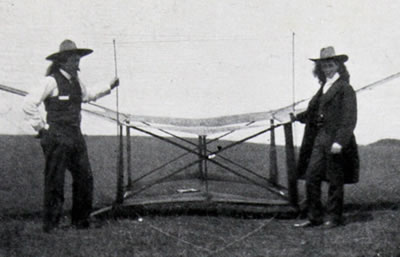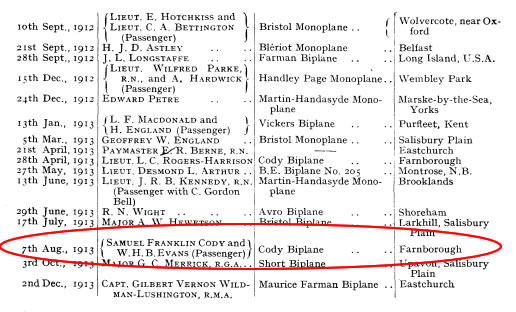To celebrate the new ‘Early Aviation Collection’ of records, biographies and images that are now uniquely available on TheGenealogist, all fully categorised in one easy to view collection, we’ve taken a look at one of the trailblazers in the history of early flight in Britain. The early aviators were all heroes and celebrities of the time, enthralling the public both in Britain and overseas.
One of the leading celebrities at the time in Britain was the American showman, Samuel Franklin Cody. Born Samuel Franklin Cowdery, in the United States around 1860, he started his working life as a cowboy. He excelled at this, becoming a ‘trail boss’ whilst still in his teens. Here he learnt his cowboy and sharpshooter skills which led to his wild west shows in Britain and Europe.
“Sharpshooter, cowboy and pistol shot’ to “daring aviator’
His unconventional life continued when his wife, Maud, returned home to the United States. Cody then began a working and personal relationship with an English actress, Lela, who took his name even though they were never married.
Using his cowboy skills and touring with his new family, he developed a dramatic stage show. Shooting cigarettes out of Lela’s mouth, shooting apples off the top of two boys heads’ whilst galloping on horseback and other daring feats gained the show widespread popularity. On the Census records, Lela uses a number of different names for herself, adding to the element of mystery as the family moved around.
Here we see the family appearing twice on the 1901 Census whilst touring near Chester:
With the money he made from his shows (his self-publicised links to Buffalo Bill and Annie Oakley also intrigued the British public), he had the funds to develop his long-held interest in kite flying.
Settling down in Farnborough
The family stopped their nomadic lifestyle, settling down in Frimley, near Farnborough as we can see from the 1911 Census:
Cody’s subsequent employment as an aeronautical engineer with the British Army gave him a guaranteed income and eventually led to the ‘Cody Kites’ which were used by the British Army for observation.

He worked with the army on training, gliders and then on airship development, but his passion grew for powered aircrafts. He received funding from the war office and after just a year of construction he was testing ‘British Army Aeroplane No.1’ in 1908. Progressing from just a few hops and bumps, by 16th October 1908, he achieved the first powered flight in Britain in an aircraft and made front page headlines.
Access Over a Billion Records
Try a four-month Diamond subscription and we’ll apply a lifetime discount making it just £44.95 (standard price £64.95). You’ll gain access to all of our exclusive record collections and unique search tools (Along with Censuses, BMDs, Wills and more), providing you with the best resources online to discover your family history story.
We’ll also give you a free 12-month subscription to Discover Your Ancestors online magazine (worth £24.99), so you can read more great Family History research articles like this!
Ever the showman, in 1909 at one of Britain’s first aviation meetings at Doncaster, he signed the forms to become a naturalised Briton and took an ‘Oath of Allegiance’ on becoming a British subject, in front of a large crowd and the press. It brightened the day as flying had been restricted by bad weather!
There is a copy of the Aviators Certificates for both Samuel Franklin Cody in 1910 and his son, Samuel Franklin Leslie Cody in 1915, issued by the Royal Aero Club, available on TheGenealogist.
Cody continually pushed the boundaries and he was renowned for his courage that saw him outperform a number of much younger pilots. Entering many competitions, in 1910 and 1911, he won the Michelin Trophy for the longest duration flight over a 2 mile circuit. Other competition success followed.
However, this wasn’t to last he moved on to testing his new design project ‘The Cody Floatplane’ on 7 August 1913. This tragically broke up at 500 feet killing him and his guest passenger, the cricketer William Evans.
One of the great colourful characters of early flight was lost and he was very publicly mourned by the British people who had taken the American to their hearts. He held the record height achieved for a kite, designed the first ‘man- carrying’ kite and had been involved in the construction of the airship as well as his powered flight exploits. Thousands of people lined the route of the funeral cortege, and he is commemorated at Farnborough Air Sciences Trust, where so much of the pioneering feats took place.

The ‘aviation fatality’ record can be viewed on the new records on TheGenealogist.
The family of his wife, Maud, in America then embarked on a successful legal quest to access the estate of Samuel Cody. Things were never straightforward with Samuel Cody even after his death!
Tragedy continued for those bearing the Cody name when his son, Samuel Franklin Cody was killed in 1917 during the First World War. His records are all on TheGenealogist.
There’s an extensive range of pilot records now on TheGenealogist from 1909, looking at Aero Club members, Aeronaut certificates, airship certificates and the sadly all too frequent fatalities as our forebears strove to conquer the skies. If you have an ancestor who was one of the pioneers of flight, there’s now a great resource to explore on TheGenealogist.






